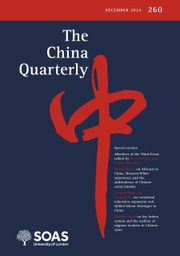Article contents
Negotiating the Space of Civil Autonomy in Hong Kong: Power, Discourses and Dramaturgical Representations
Published online by Cambridge University Press: 28 September 2004
Abstract
This article delineates the negotiated space of civil autonomy in post-handover Hong Kong through the contingent interplay of law, discourse, dramaturgy and politics. It takes the Public Order Ordinance dispute in 2000 as the first major test case of civil conflicts in the shadow of the right of abode struggle. As it unfolded, the event demonstrated both the power and limits of resistance by the people, and the government's increasing will, as well as the strategies it used, to rule within the “law and order” framework under continual challenges. In the event, civil autonomy had been a contested issue involving considerations of rule of law, rights, civic propriety, state legitimacy and the construction of particular identity (such as student-hood). Given the multiplicity of discourses and sub-discourses, citizenship practices and public criticisms opened up a contested space for resistance and negotiation. A campaign of civil disobedience was at first successfully mounted through an ensemble of political and symbolic mechanisms. A turning point was configured when, mediated by a meaning reconstruction process, the government made a series of political and performative acts to re-script the drama, which turned out to be an ironic success for itself that put state–society relations on an increasingly tenuous course. Ultimately ideological differences were at stake: respect for a rights-based discourse of rule of law versus the assertion of political and legal authoritarianism.
- Type
- Research Article
- Information
- Copyright
- © The China Quarterly, 2004
- 23
- Cited by


